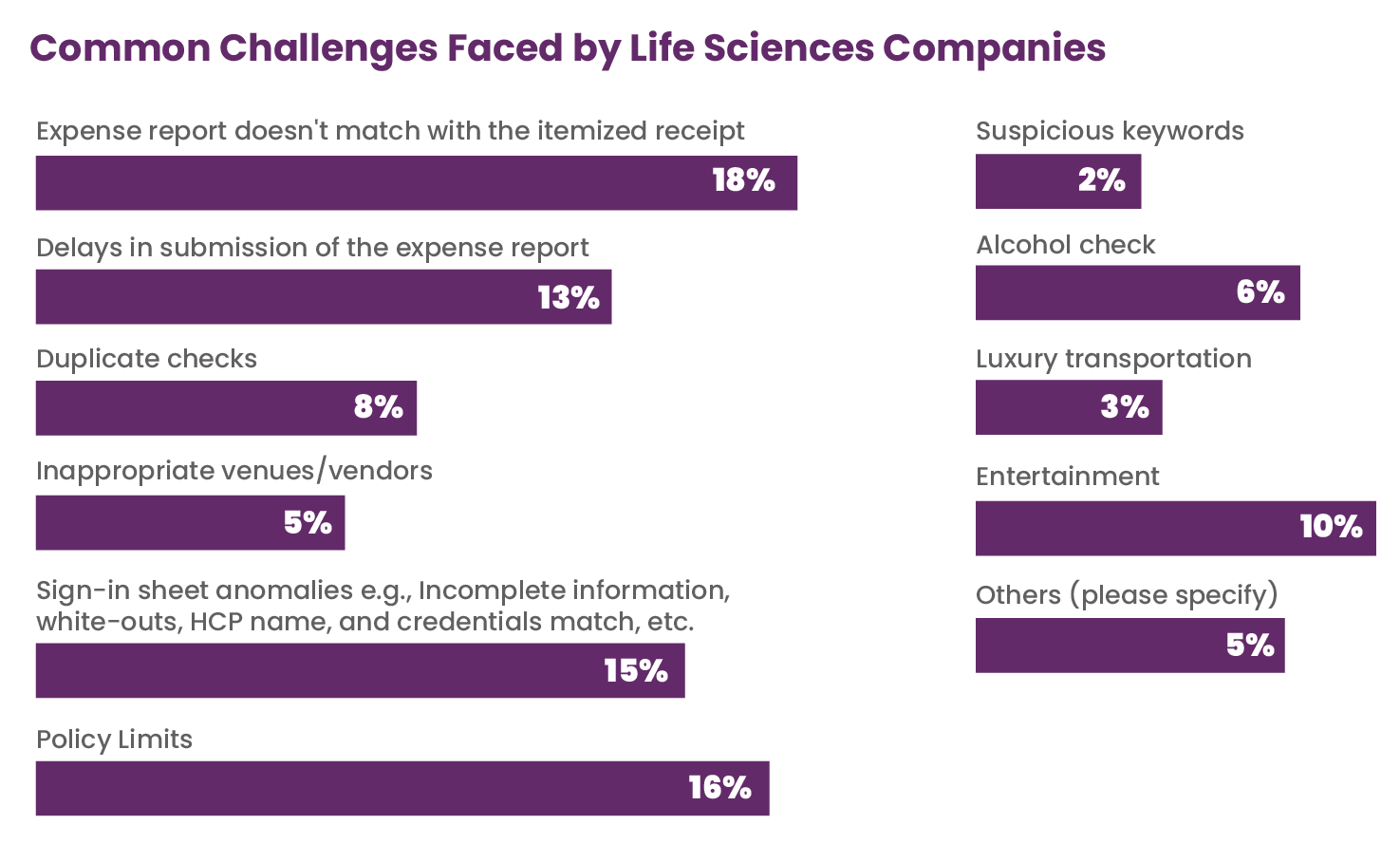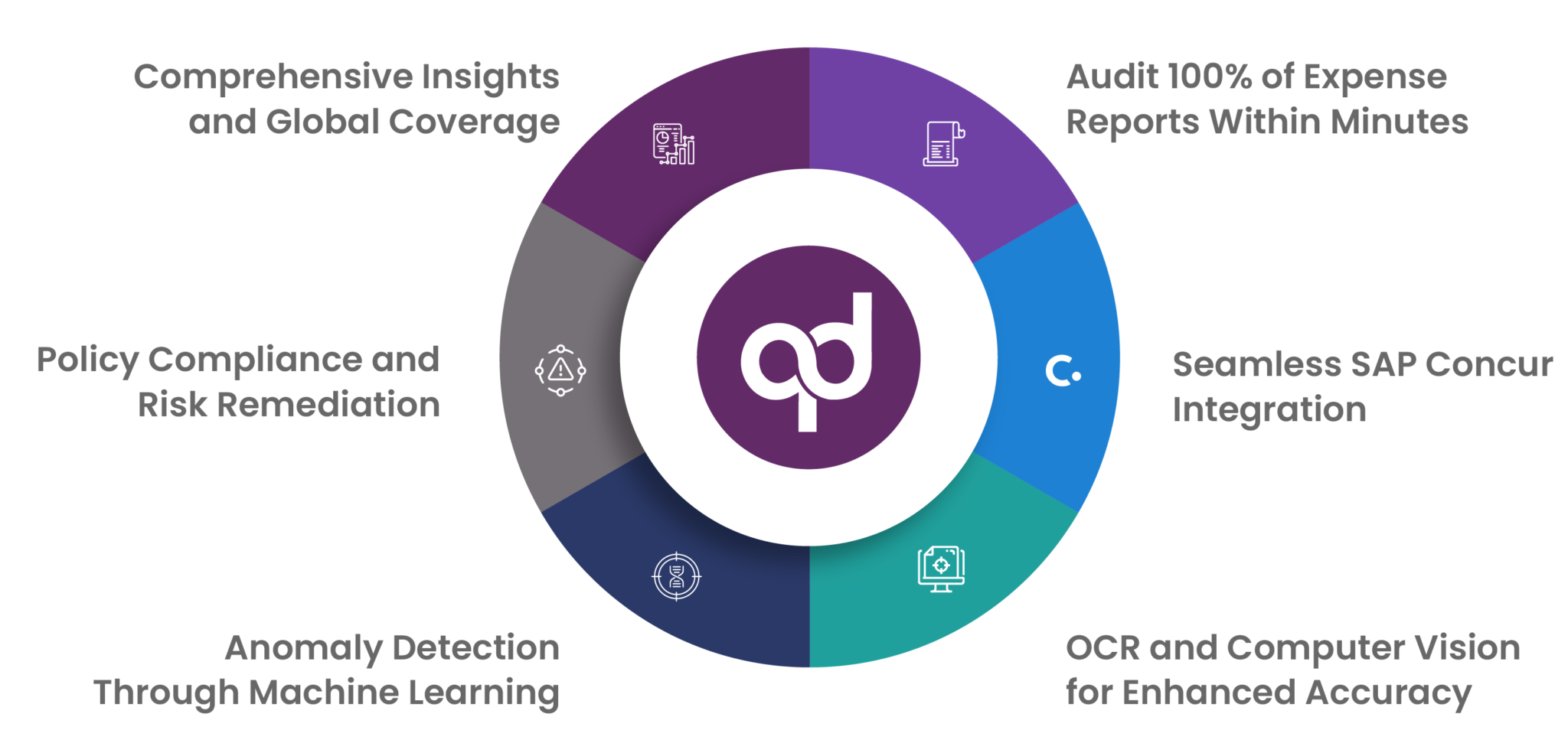Expense report fraud is a big problem, especially in the life sciences industry where following rules and regulations is quite important. From falsified receipts to inflated claims, fraudulent expense reporting can have severe consequences.
As a compliance officer, it’s essential to have a robust compliance strategy to identify, reduce, and ultimately prevent such fraud. In this blog, we’ll delve into various types of expense report fraud, the impact it can have, and how to effectively combat it using automated expense monitoring and auditing with artificial intelligence (AI) and machine learning (ML).
Understanding Different Types of Expense Report Fraud
In the life sciences industry, where engagements with healthcare professionals (HCPs) and other stakeholders are frequent and complex, the risk of expense reporting fraud is even higher. Regulatory bodies such as the Centers for Medicare & Medicaid Services (CMS), Office of Inspector General (OIG), and the Department of Justice (DOJ) scrutinize expense reports to ensure compliance with laws like the Anti-Kickback Statute (AKS) and the Foreign Corrupt Practices Act (FCPA) and more. This ensures that a life sciences company is maintaining transparency and accountability.
Expense report fraud refers to any intentional misrepresentation of expenses by employees to receive reimbursements to which they are not entitled. These fraudulent activities not only result in financial loss but also expose the company to significant compliance risks. The impact of expense report fraud extends beyond monetary loss, potentially leading to legal repercussions and damaging the company’s reputation.
Identifying and Reducing Expense Report Fraud
Identifying how expense report fraud can occur is the first step in mitigating it. Common examples of expense fraud schemes include:
- Mischaracterized Expense Fraud: Submitting personal expenses as if they were business-related.
- Falsified Claim Expense Fraud: Altering receipts or fabricating expenses.
- Inflated Claims Expense Fraud: Exaggerating the costs of legitimate expenses.
- Multiple Claim Expense Fraud: Submitting the same expense multiple times for reimbursement.
To combat these fraudulent activities, it’s crucial to have a clear expense policy in place. This policy should outline acceptable expenses, the documentation required for reimbursement, and the consequences of non-compliance. Regular training on expense compliance is also essential to ensure that employees understand the rules and are aware of the penalties for fraudulent behavior.
Insights: Expense Reporting Challenges for Life Science Companies
At the 3rd Transparency and Aggregate Spend Summit held in 2024 by Dynamic Global Events, a poll was conducted to identify the specific scenarios in which life sciences companies were challenged within their compliance processes. The poll results provide valuable insights into the common pain points experienced by professionals in the life sciences industry.
-
Expense Report Mismatch with Itemized Receipts:
The most significant challenge faced by attendees was ensuring that expense reports match with itemized receipts. This indicates a strong need for more robust expense management systems that can automatically reconcile expense reports with corresponding receipts to reduce discrepancies and prevent potential compliance issues.
-
Delays in Submission of Expense Reports:
Timeliness in submitting expense reports is another major concern. Delayed submissions can lead to financial inaccuracies and hinder the transparency of financial dealings. In such cases, life sciences companies need complete visibility of their data to ensure accurate and timely CMS open payments reporting as per US Federal and State requirements.
-
Significant Percentage Concerned with Policy Limits and Suspicious Keywords
Policy Limits were identified as a challenge by 16% of the participants. This suggests that many companies struggle with ensuring that their expenses stay within predefined policy limits. This issue can be mitigated by implementing automated compliance monitoring tools that can flag or even prevent transactions that exceed set thresholds.
Suspicious Keywords were a concern for 2% of the participants, indicating that while this is not a widespread issue, it still requires attention to ensure that any potentially fraudulent or non-compliant activity is promptly identified.
-
Sign-in Sheets Anomalies Detection
Anomalies in sign-in sheets, such as incomplete information and mismatches in HCP credentials, were highlighted by 15% of the participants. This underscores the need for better data validation processes and integration with HCP engagement platforms to ensure accuracy.
-
Duplicate Checks and Inappropriate Venues/Vendors:
While not as prominent, duplicate checks (8%) and the use of inappropriate venues or vendors (5%) were also identified as areas of concern. These issues can lead to significant compliance risks and emphasize the necessity for stringent review processes and clear vendor selection criteria.
-
Luxury Transportation and Alcohol Check:
Luxury transportation and alcohol-related expenses, though less frequent concerns (3% and 6%, respectively), are still areas that need attention, particularly in terms of aligning with company policies and ensuring that such expenditures are highlighted and justified.
The Role of Technology in Combatting Expense Reporting Fraud
As the complexities of expense reporting in the life sciences industry continue to grow, relying solely on manual processes and traditional auditing methods is no longer sufficient. The dynamic nature of engagements, the intricate regulatory landscape, and the sheer volume of transactions make it challenging to ensure accuracy and compliance. This is where advanced technology, particularly Artificial Intelligence (AI) and Machine Learning (ML), becomes crucial. qordata’s Expense Monitoring & Auditing (EMA) solution offers an innovative approach to effectively manage and mitigate the risks associated with expense reporting fraud.
Traditional auditing often involves sampling a subset of expense reports, which can lead to missed discrepancies and potential compliance breaches. qordata’s EMA solution revolutionizes this process by enabling a 100% audit of all expense reports within a minute. By leveraging AI and ML, the solution ensures that every single expense report is thoroughly analyzed, drastically reducing the chance of fraudulent activities going unnoticed.
qordata’s EMA solution integrates seamlessly with SAP Concur and other travel and expense (T&E) management systems. This integration allows for the automatic extraction and real-time monitoring of expense reports, ensuring that all data is accurate and up-to-date. The system’s ability to connect with existing T&E platforms streamlines the auditing process, making it both efficient and effective.
One of the significant challenges in expense reporting is the manual entry and verification of data from receipts, boarding passes, and sign-in sheets. qordata’s solution utilizes Optical Character Recognition (OCR) and computer vision technology to convert these documents into machine-readable text. This automation not only speeds up the process but also minimizes human errors, ensuring that expense reports are reconciled accurately against the corresponding documentation.
Expense report fraud often involves subtle alterations or anomalies in supporting documents, such as sign-in sheets. qordata’s EMA solution employs ML algorithms to detect these anomalies, such as white-outs, incomplete information, and duplicate signatures. The system’s ability to flag unusual patterns and discrepancies allows auditors to focus on high-risk transactions, enhancing the overall integrity of the auditing process.
Staying compliant with company, state, and country-specific policies is paramount in the life sciences industry. qordata’s EMA solution continuously monitors expenses against these requirements, automatically flagging any non-compliant transactions. This real-time compliance check helps prevent potential regulatory breaches and the associated penalties.
Additionally, the solution’s risk remediation capabilities allow compliance officers to manage high-risk expense reports and representatives more effectively. By consolidating expense data and providing comprehensive insights, qordata’s EMA solution empowers organizations to take proactive measures, ensuring that risky transactions are swiftly addressed and compliance is maintained.
In a global industry like life sciences, having a solution that offers global coverage is essential. qordata’s EMA solution provides comprehensive analytics and insights, giving organizations a clear view of their expense reporting processes across different regions. This global perspective helps companies ensure that their compliance strategies are aligned with international standards, further reducing the risk of fraud and non-compliance.
The Importance of a Clear Expense Policy
A clear and well-communicated expense policy is the foundation of any effective fraud prevention strategy. Your policy should clearly define:
- Acceptable and Non-Acceptable Expenses: Outline what qualifies as a business expense and what does not.
- Documentation Requirements: Specify the type of documentation required for each type of expense.
- Reimbursement Process: Detail the steps for submitting expenses and the approval process.
- Consequences of Non-Compliance: Clearly state the penalties for submitting fraudulent expenses.
Regularly updating your policy to address new types of fraud and ensuring that all employees are trained on the latest guidelines is crucial to maintaining compliance.
Conclusion
Expense report fraud is a persistent challenge that requires a multifaceted approach to manage effectively. By implementing clear policies, conducting regular training, and leveraging advanced technology like qordata’s EMA solution, life sciences companies can significantly reduce the risk of fraudulent expense reimbursement cases.
The consequences of inefficient expense policies and inadequate oversight are too great to ignore. With qordata’s EMA solution, you can automate your expense process, thoroughly audit every report, and ensure compliance with your company’s travel and expense spend guidelines. By taking these proactive steps, you’ll not only protect your organization from financial loss but also uphold the integrity of your compliance program.
Invest in the right tools today to ensure that your expense reporting process is both fraud-resistant and compliant with industry standards.
Other Relevant Reads:





